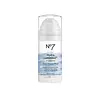What's inside
What's inside
 Key Ingredients
Key Ingredients

 Benefits
Benefits

 Concerns
Concerns

 Ingredients Side-by-side
Ingredients Side-by-side

Water
Skin ConditioningGlycerin
HumectantAlcohol Denat.
AntimicrobialNiacinamide
SmoothingDipropylene Glycol
HumectantPentylene Glycol
Skin ConditioningButylene Glycol
HumectantPEG-8
HumectantPEG/PPG/Polybutylene Glycol-8/5/3 Glycerin
HumectantPEG-60 Hydrogenated Castor Oil
EmulsifyingCI 61570
Cosmetic ColorantCarbomer
Emulsion StabilisingTriethanolamine
BufferingPhenoxyethanol
PreservativeAmmonium Polyacryloyldimethyl Taurate
Emulsion StabilisingTetrasodium EDTA
Menthoxypropanediol
MaskingT-Butyl Alcohol
PerfumingParfum
MaskingWater, Glycerin, Alcohol Denat., Niacinamide, Dipropylene Glycol, Pentylene Glycol, Butylene Glycol, PEG-8, PEG/PPG/Polybutylene Glycol-8/5/3 Glycerin, PEG-60 Hydrogenated Castor Oil, CI 61570, Carbomer, Triethanolamine, Phenoxyethanol, Ammonium Polyacryloyldimethyl Taurate, Tetrasodium EDTA, Menthoxypropanediol, T-Butyl Alcohol, Parfum
Water
Skin ConditioningGlycerin
HumectantC12-15 Alkyl Benzoate
AntimicrobialNiacinamide
SmoothingButylene Glycol
HumectantIsononyl Isononanoate
EmollientParaffinum Liquidum
EmollientCetyl PEG/PPG-10/1 Dimethicone
EmulsifyingCarbomer
Emulsion StabilisingPhenoxyethanol
PreservativePolyglyceryl-4 Isostearate
EmulsifyingHexyl Laurate
EmollientMagnesium Sulfate
Theobroma Cacao Seed Butter
EmollientTocopheryl Acetate
AntioxidantCera Microcristallina
Emulsion StabilisingParaffin
PerfumingMethylparaben
PreservativeSodium Hyaluronate
HumectantAscorbyl Glucoside
AntioxidantPropylene Glycol
HumectantSodium Hydroxide
BufferingEthylparaben
PreservativeTetrasodium EDTA
Panax Ginseng Root Extract
EmollientBiosaccharide Gum-4
Skin ConditioningBiosaccharide Gum-1
HumectantMorus Alba Leaf Extract
Skin ConditioningCI 42090
Cosmetic ColorantPentaerythrityl Tetra-Di-T-Butyl Hydroxyhydrocinnamate
AntioxidantWater, Glycerin, C12-15 Alkyl Benzoate, Niacinamide, Butylene Glycol, Isononyl Isononanoate, Paraffinum Liquidum, Cetyl PEG/PPG-10/1 Dimethicone, Carbomer, Phenoxyethanol, Polyglyceryl-4 Isostearate, Hexyl Laurate, Magnesium Sulfate, Theobroma Cacao Seed Butter, Tocopheryl Acetate, Cera Microcristallina, Paraffin, Methylparaben, Sodium Hyaluronate, Ascorbyl Glucoside, Propylene Glycol, Sodium Hydroxide, Ethylparaben, Tetrasodium EDTA, Panax Ginseng Root Extract, Biosaccharide Gum-4, Biosaccharide Gum-1, Morus Alba Leaf Extract, CI 42090, Pentaerythrityl Tetra-Di-T-Butyl Hydroxyhydrocinnamate
 Reviews
Reviews

Ingredients Explained
These ingredients are found in both products.
Ingredients higher up in an ingredient list are typically present in a larger amount.
Butylene Glycol (or BG) is used within cosmetic products for a few different reasons:
Overall, Butylene Glycol is a safe and well-rounded ingredient that works well with other ingredients.
Though this ingredient works well with most skin types, some people with sensitive skin may experience a reaction such as allergic rashes, closed comedones, or itchiness.
Learn more about Butylene GlycolCarbomer is a polymer of acrylic acid. Its main role is to create a gel consistency.
A high amount of carbomer can cause pilling or balling up of products. Don't worry, most products contain 1% or less of carbomer.
Glycerin is already naturally found in your skin. It helps moisturize and protect your skin.
A study from 2016 found glycerin to be more effective as a humectant than AHAs and hyaluronic acid.
As a humectant, it helps the skin stay hydrated by pulling moisture to your skin. The low molecular weight of glycerin allows it to pull moisture into the deeper layers of your skin.
Hydrated skin improves your skin barrier; Your skin barrier helps protect against irritants and bacteria.
Glycerin has also been found to have antimicrobial and antiviral properties. Due to these properties, glycerin is often used in wound and burn treatments.
In cosmetics, glycerin is usually derived from plants such as soybean or palm. However, it can also be sourced from animals, such as tallow or animal fat.
This ingredient is organic, colorless, odorless, and non-toxic.
Glycerin is the name for this ingredient in American English. British English uses Glycerol/Glycerine.
Learn more about GlycerinNiacinamide is a multitasking form of vitamin B3 that strengthens the skin barrier, reduces pores and dark spots, regulates oil, and improves signs of aging.
And the best part? It's gentle and well-tolerated by most skin types, including sensitive and reactive skin.
You might have heard of "niacin flush", or the reddening of skin that causes itchiness. Niacinamide has not been found to cause this.
In very rare cases, some individuals may not be able to tolerate niacinamide at all or experience an allergic reaction to it.
If you are experiencing flaking, irritation, and dryness with this ingredient, be sure to double check all your products as this ingredient can be found in all categories of skincare.
When incorporating niacinamide into your routine, look out for concentration amounts. Typically, 5% niacinamide provides benefits such as fading dark spots. However, if you have sensitive skin, it is better to begin with a smaller concentration.
When you apply niacinamide to your skin, your body converts it into nicotinamide adenine dinucleotide (NAD). NAD is an essential coenzyme that is already found in your cells as "fuel" and powers countless biological processes.
In your skin, NAD helps repair cell damage, produce new healthy cells, support collagen production, strengthen the skin barrier, and fight environmental stressors (like UV and pollution).
Our natural NAD levels start to decline with age, leading to slower skin repair, visible aging, and a weaker skin barrier. By providing your skin niacinamide, you're recharging your skin's NAD levels. This leads to stronger, healthier, and younger looking skin.
Another name for vitamin B3 is nicotinamide. This vitamin is water-soluble and our bodies don't store it. We obtain Vitamin B3 from either food or skincare. Meat, fish, wheat, yeast, and leafy greens contain vitamin B3.
The type of niacinamide used in skincare is synthetically created.
Learn more about NiacinamidePhenoxyethanol is a preservative that has germicide, antimicrobial, and aromatic properties. Studies show that phenoxyethanol can prevent microbial growth. By itself, it has a scent that is similar to that of a rose.
It's often used in formulations along with Caprylyl Glycol to preserve the shelf life of products.
Tetrasodium EDTA is the salt formed from neutralizing ethylenediamine tetraacetic acid with sodium hydroxide. It is a chelating agent and used to prevent metal ions from binding to other ingredients. This helps keep the product and ingredients stable.
Tetrasodium EDTA comes as a white solid and is soluble in water.
Water. It's the most common cosmetic ingredient of all. You'll usually see it at the top of ingredient lists, meaning that it makes up the largest part of the product.
So why is it so popular? Water most often acts as a solvent - this means that it helps dissolve other ingredients into the formulation.
You'll also recognize water as that liquid we all need to stay alive. If you see this, drink a glass of water. Stay hydrated!
Learn more about Water